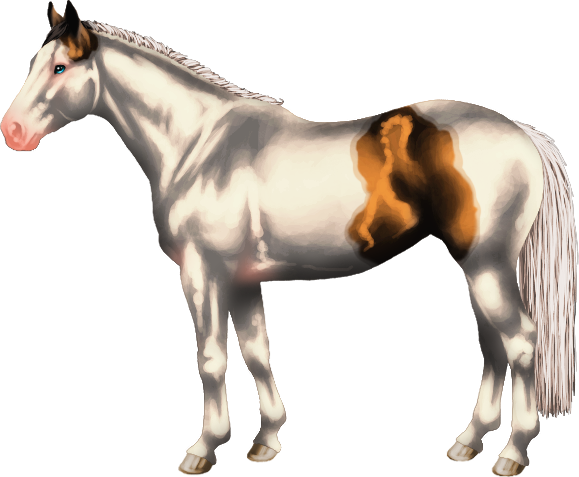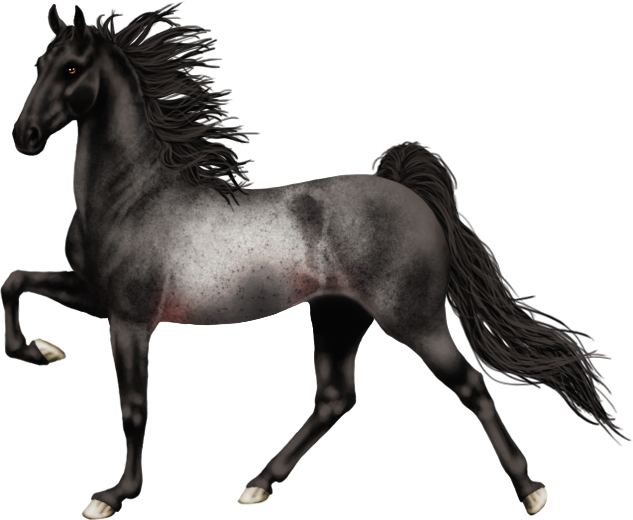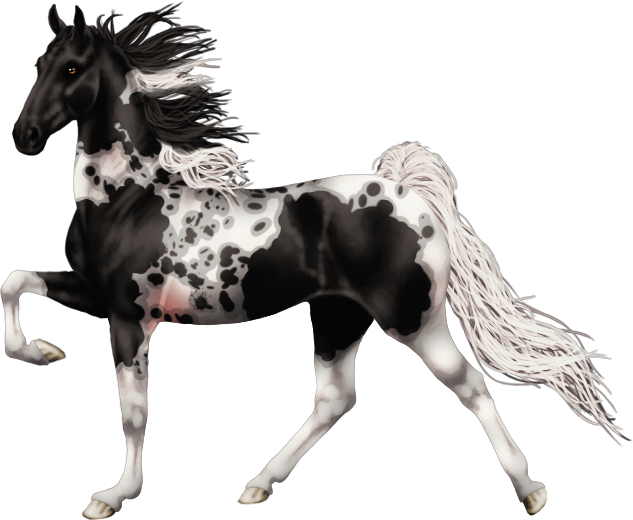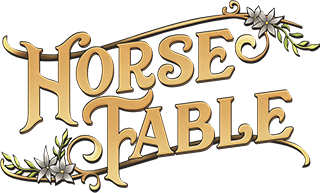
KIT Genes
The KIT genes are sabino (Sa1), tobiano (To), roan (Rn), and dominant white (W#). Horses may only have two KIT genes. This means horses can only have two KIT patterns such as sabino and tobiano, roan and tobiano, sabino and dominant white etc.. A sabino roan tobiano is not a possible white pattern as it has three KIT genes being used which is not biologically possible.
Sometimes horses may look like they have three KIT genes but there are several other genes that may cause this confusion such as varnish roan (a leopard marking) or even greying horses (often confused for roans).

Sabino (Sa1)
Sabino is a white pattern typically identified by a belly patch, 4 leg markings, and a face marking. However, many sabinos also have no belly spot, leg markings only, roan-like patterns, and sometimes even cover most of the body in white.
In Horse Fable, Sa1Sa1 horses will be maximum sabinos and display a larger amount of white than most Sa1n horses do.
Roan (Rn)
Roan is a white pattern that scatters white hairs across a horse’s body. Roan and greying horses often get confused and horse coat color misidentified thus, many registries have horses registered as “roan” that are not.
In Horse Fable, Roan comes in the traditional roan as well as corn roan. Corn roan has spots of solid color scattered throughout the horses roan patterning. Horses that are RnRn will display more roaning than those that are Rnn.


Tobiano (To)
The tobiano gene adds large portions of white to a horse and typically is identified by the white crossing the horse’s topline. However, some horses may be considered “slipped tobiano” or “cryptic tobianos”. These types test with a tobiano gene (TO) but do not have the standard tobiano phenotype. In Horse Fable, horses that are ToTo re maximum tobianos and typically have more white than Ton horses.
Some tobianos have small spots within the white that is called “cat tracks” or “Belton”. This is typically seen in homozygous tobianos (ToTo) but can be seen in heterozygous (Ton). In Horse Fable some tobiano patterns do have cat tracks.
Dominant White (W#)
Dominant white is a white pattern that causes horses to be mostly if not all, white. Dominant white is believed to be lethal in some cases but is currently not in Horse Fable.
The dominant white gene is often being discovered in many breeds, mostly W20, but exists in W1 – 22+ and counting. Each W# is typically specific to a certain breed and family line with the exception of W20.
W20 is believed to be a “white boosting” gene that causes other white markings to display more loudly. On its own, W20 either appears as minimally white or potentially not at all. In Horse Fable, the W20 gene displays as a minimal sabino phenotype but in its homozygous form (W20W20) will display an all-white horse or a mostly all-white horse.
Breeds that have other white variations such as W6 or W15 will display a white pattern similar to the horses that the gene was discovered in. To the right is an Arabian displaying the W3 gene that was modeled after Arabian Stallion, R Khapser.
Albino Horses
White horses or horses that appear solid white are often labeled as “Albino”. Albino has never been seen in horses and is believed to not be possible. Horses cannot be albino as they still have pigment in their eyes and some areas of skin. For example, a solid white dominant white horse still has pigment in its eyes giving them typically eye colors like brown and sometimes blue. Referring to a horse as “albino” is not correct and horses that are phenotypically all-white should be referred to as white or by the markings present.

